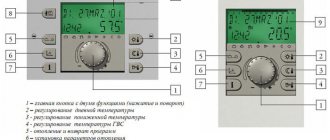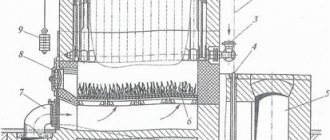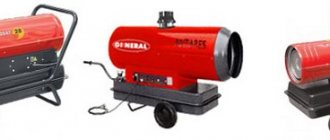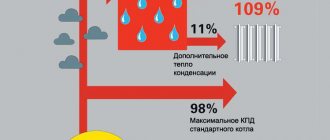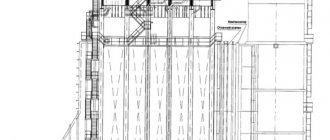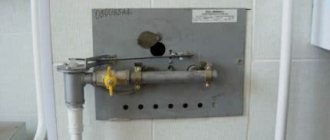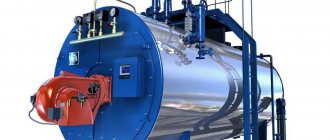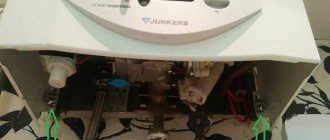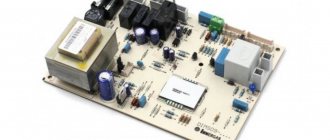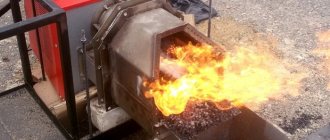Diesel burner options
Diesel fuel burners are devices that prepare fuel for ignition in the combustion chamber. They are all divided according to the following principles:
- For fuel combustion - burners with nozzles that spray fuel into tiny particles with air, as well as burners with preliminary gasification and evaporative burners.
- By type of fuel burned: burners intended only for liquid fuel, and combined burners, can be used for two types of fuel (liquid and gaseous, i.e. gas-diesel burners).
- According to the operating mode of diesel burners: two-stage, single-stage, modulating.
Operating principle of the burner
The nozzle is one of the main components of the burner, with the help of which fuel is atomized in diesel heating boilers. The operating principle of such a nozzle for diesel burners occurs in several stages:
1).Fuel supply. The fuel is stored inside the fuel tank. It is transported through fuel lines thanks to a fuel pump.
2).Fuel filtration. Any type of fuel can become contaminated. Based on this, before the fuel enters the burner, it is cleaned using a fuel filter. This filter is necessary; it removes various mechanical impurities, after which the purified fuel enters the preheating chamber. This procedure is important to reduce viscosity. The heating temperature is maintained automatically.
3).The process of burning fuel. Fuel is supplied from the heating chamber according to the injection principle: with the help of a strong flow of compressed air, a vacuum process is created in the fuel pipeline, and fuel is sucked in. As a result, the air flow and fuel, mixing, enter the nozzle. Inside the nozzle, the liquid is sprayed into tiny droplets, filling the entire volume of the combustion chamber. A strong, compressed air flow is created by the compressor. Secondary air is supplied by a fan equipped with a special damper for adjustment.
4). Ignition of fuel. The process of igniting liquid fuel occurs automatically thanks to electrodes or ignition transformers.
Smoothly stepped and modulating equipment
In smooth-step installations, unlike two-stage ones, the flame temperature is controlled within a user-defined range. The increase in operating power occurs gradually as the boiler cools, and not abruptly. In this regard, fuel consumption is reduced and maintenance costs are reduced. The disadvantages of the systems are the high cost and high requirements for the power grid - it must be stable.
Modulating designs are the most economical and convenient options available for installation in a diesel boiler. The heating is regulated by microprocessor technology, which measures the air temperature in the room, the state of the combustible mixture and gives a signal when the flame power increases or decreases. Significant disadvantages are the high price, complex design, and high maintenance costs.
Selecting the burner operating mode
As a rule, burners have an automatic control unit that monitors the safety of the equipment and its temperature.
The burner can operate in the following modes:
- In single-stage mode, i.e. always at 100% power. In this case, the coolant temperature is regulated by constantly turning the burner on and off.
- In two-stage mode - the burner operates at both full 100% power and only 40%.
- In a two-stage intermediate mode - here the burner power smoothly switches between 40% and 100%.
- In modulated mode – i.e. adjustment of the coolant temperature occurs due to smooth switching of the burner power within the range from 10% to 100% of its power.
As for the choice of fuel, it has its own requirements, which you can find directly in the burner passport.
Boiler design
A diesel boiler consists of a control unit, a combustion chamber, a diesel burner, a heat exchanger, a filter for filtering fuel, and a chimney.
Control block
needed to adjust the automatic operation of the burner and pump. With its help, you can control the temperature and adjust it depending on weather conditions and your preferred microclimate.
In the combustion chamber
The fuel used for heating is burned. When choosing the appropriate equipment, it is necessary to take into account such an indicator as the coefficient of specific resistance of the combustion chamber.
Diesel burner
needs to be properly configured, since the operation of this element affects the heating of the heating system and how much fuel is required and whether it can be saved.
In the heat exchanger
The coolant heats up. Heating is based on the principle of heat energy exchange in the area between the heat exchanger and the combustion chamber.
Filter
is used to prevent debris and dirt from entering the burner, and the reliability of the entire system depends on how correctly the chimney is installed.
It’s worth noting right away that a heating system using a diesel type, by definition, cannot be cheap
. However, financial costs can be reduced through high-quality insulation of the house, as well as periodic maintenance of installed equipment.
How to install the burner
The diesel burner should be installed after the boiler and chimney are installed. The burner installation process also involves the installation of additional equipment, namely, a fuel tank with a float, a filter, a pump, a piping system, a compressor, a fan and a burner with control modes and an ignition system.
Some diesel burners have all the necessary elements and therefore such burners do not require the installation of additional equipment.
The efficient and safe operation of the entire heating boiler depends on how correctly the burner is installed. Therefore, for proper installation of the burner, you should adhere to the rules for installation work. It is better to seek the services of professional craftsmen.
DIY burner installation
Installation of the burner should be carried out by experienced professionals, especially if the gas generator and the boiler are under warranty.
However, during operation, situations often arise when operating personnel must install the LTG with their own hands. This process is multi-stage and consists of the following stages:
- installation of control valves on the fuel supply line in front of the burner;
- installation of liquid fuel gas on the front panel of the boiler;
- connecting electrical connectors and ramps;
- installation of a diesel fuel sprayer;
- nozzle installation;
- starting the burner;
- setting up and testing the combustion process with a gas analyzer.
Connection to the power line is carried out according to the electrical diagram specified by the manufacturer in the instructions. When installing fuel lines, their length must be selected in such a way that it is possible to tilt the burner device while servicing the boiler.
Electronic controllers are very susceptible to voltage surges, and therefore it is recommended to connect them to the mains through a stabilizer. In this case, the device will operate for the entire design period and unscheduled repairs of diesel burners will not be required.
Burner setup + servicing
Setting up a diesel burner should be done by the specialists who installed it. They are the ones who must configure it for a specific type of fuel. However, burners also require attention during operation. Their components experience strong temperature changes, clogging of fuel paths (from poor quality diesel fuel), which subsequently leads to breakdowns and disables the equipment. Therefore, to extend the service life, as well as to avoid breakdowns of diesel burners, preventive maintenance should be done from time to time.
Recommended! Carry out servicing of diesel burners before the onset of the heating season!
Service includes:
- Optimization of combustion mode settings;
- Cleaning burner components;
- Replacement of worn burner parts;
- Cleaning or replacing filters;
- Analysis of processed products.
So, now let’s figure out how to set up a diesel burner:
Once the burner is installed, it needs to be adjusted. Everything regarding the burner settings, all requirements and rules, you can find in its passport.
So, using the Lamborghini ECO3r diesel burner as an example, we’ll tell you how to set it up yourself. This setup consists of several steps:
1).Preparation of tools and equipment (pressure gauge, gas analyzer, soot measurement test, fuel pump, installation tool).
2).Next, remove the burner cover.
3).Then we connect the nipple for connecting the fuel hoses, taking into account that the chamfer is on the outside. Important! For better sealing, it is necessary to use aluminum gaskets.
4).Connect the hoses to the fuel pump.
5).Now we disconnect the front panel from the body with the nozzle.
6).Select the nozzle taking into account the power of the boiler. Its main characteristics: angle, spray intensity, nominal flow rate. When the injector operates properly, a “fuel cloud” should form, which is evenly distributed throughout the combustion chamber.
7).Remove the deflector to install the nozzle.
9).Connect the burner to the mains.
10).Now we install the ignition electrode so that the spark is close to the fuel outlet from the injector.
11).Set the required pressure from 9 bar to 14 bar on the solenoid valve, using a pressure gauge and adjustment screw.
12).Finally, the time has come to pump fuel into the burner, first we do a test run.
The displays of the burner control indicate the state of the burner. In case of an accident – red, when warming up – yellow, in normal condition – green.
13).When installing the burner on the boiler, the air should be adjusted so that the quality of the combustion products matches the following values: CO up to 200ppm; 02 from 3.5 ppm to 5.5 ppm; CO2 from 11.5 ppm to 13.5 ppm.
14).Using the diffuser (its movement), fine tuning of the burner is carried out. In other words, the efficiency of the burner is increased by adjusting the strength of the secondary air supply, as well as adjusting the shape of the flame.
And here is another video example of setting up a Lamborghini burner, but not ECO3R, but ECO5R:
In order for the diesel burner to function normally, as well as for defects found in time, one should not forget about its prevention. With constant use of the boiler, maintenance is carried out once every six months; in case of seasonal operation, it must be done once a year.
Diagnostics and troubleshooting of diesel burner. (10+)
Diesel burner – Malfunctions, diagnostics, repairs
Burner malfunction may be caused by poor quality fuel or breakdown. Finding out and eliminating the cause is sometimes easy, but sometimes it requires contacting a service center.
Burner repair involves contact with mains electricity and work with flammable liquids. Make sure you are properly qualified to do this. Read and follow safety precautions
.
When turning on the burner disassembled, understand how you will quickly turn it off
. Create conditions so that shutdown does not require much time.
Be prepared for accidental ignition
. Wear glasses when working, get a fire extinguisher, and learn how to use it.
Equipment setup
The installation and adjustment of a diesel burner should only be carried out by specialists. You should not do this yourself. The whole point is that the master adjusts the nozzle for the diesel burner - how it will spray the combustible mixture.
If adjusted incorrectly, the amount of sprayed mixture will be excessive, which will lead to its detonation and explosion of the heating equipment. Otherwise, the amount of fuel supplied may be insufficient to maintain the specified temperature.
Today the most popular is the Lamborghini diesel burner from Italy. In second place are the companies Elco, Baltur, Ferroli. When choosing the optimal equipment, you need to pay attention to the power, design, presence of a fuel heater, and only then to its cost. Only in this case you will not be disappointed in the purchase.
Burner malfunctions using diesel fuel or light heating oil
The burner does not light up
Here is a selection of materials:
Everything you need to know about heating and climate control Features of the selection and maintenance of boilers and burners. Comparison of fuels (gas, diesel, oil, coal, wood, electricity). Do-it-yourself ovens. Coolant, radiators, pipes, heated floors, circulation pumps. Chimney cleaning. Conditioning
Make sure that the fuel is filled with normal fuel, without water, appropriate for the weather. Make sure that voltage is supplied to the burner (indication on the boiler and burner is on)
If everything is in order with power and fuel, there can be four reasons: no fuel supply, no air supply, no spark, too much air. It’s better to start looking for reasons by checking the fuel filter
.
If it is clogged, clean it. The presence of a spark
determined by the characteristic sound of a spark discharge. I can hear it well, but some people cannot pick it out in the general hum of the burner. Then you will have to disassemble the burner, remove the nozzle holder cover, turn off the fuel supply, for example, disassemble the fuel filter and leave it like that for the duration of the test, turn on the burner in this disassembled form. At the moment of ignition, a spark should appear. If the fuel supply is not turned off during this experiment, a torch will burst into flames in your hands. Be careful to ensure that fuel does not flow. If there is no spark, then you need to clean and rinse the ignition electrodes; if there is a lot of debris stuck to them or they are covered in diesel fuel, then there may be no spark, check the distance between them. The electrodes are fine, which means there is a problem with the transformer. It can be replaced with a homemade one.
How to make the right choice of boiler
First of all, we will define the criteria by which the choice of a home boiler installation is made. Moreover, we will place priorities in the order in which most ordinary users usually see them:
- boiler thermal power;
- cost of thermal equipment, piping and installation parts;
- fuel efficiency and operating costs;
- ease of use;
- functionality.
As for thermal power, the simplest way to calculate it for a building with a ceiling height of 3 m or less is known to everyone. This refers to the calculation of the total amount of heat for heating based on the square footage of the premises, where it is proposed to allocate 100 W of thermal energy for each m2. That is, they take the area of all floors of the building and multiply it by 0.1 kW, calculating the approximately correct amount of heat. Then this figure is further increased by a safety factor of 1.2-1.3 and, taking the result obtained as a basis, diesel boilers are selected according to power.
If you plan to use a diesel boiler to heat water for household needs, then you should take into account the additional consumption of thermal energy and add it to the figure that was calculated earlier. The amount of heat in the hot water supply is not so difficult to determine: estimate your daily hot water consumption, divide by 24 hours (get the average hourly consumption) and substitute its formula, known from a school physics course:
Q = cmΔt, where:
- Q – required amount of heat;
- с – specific heat capacity of water;
- m – mass of water;
- Δt is the temperature difference between the water entering the house and the water you want to receive from the tap.
As mentioned above, a heating boiler for diesel fuel will cost more than a gas or conventional solid fuel boiler. If we are talking only about diesel units, then it is recommended to focus on equipment in the middle price category; you should not get carried away with too cheap boilers. A striking example of the optimal price-quality ratio are PROTHERM heat generators, which have earned a reputation as inexpensive and reliable heaters in the post-Soviet space.
The wiring of a diesel boiler is as simple as that of a gas boiler; no special requirements are imposed on it. But choosing a place for a container with a supply of diesel fuel, purchasing it and installing it will take you additional time and money. Plus, it is necessary to ensure the fire safety of the premises, especially when the boiler room with a fuel tank is located inside the house. As an example, below are diagrams for connecting the fuel line to the burner with a table of diameters depending on the power of the unit and the height of the tank:
A – check valve; B — diesel fuel filter for the boiler; C – air vent; D – anti-siphon valve.
A – check valve; B — mesh filter for diesel fuel; C – air vent; D – shut-off valves.

